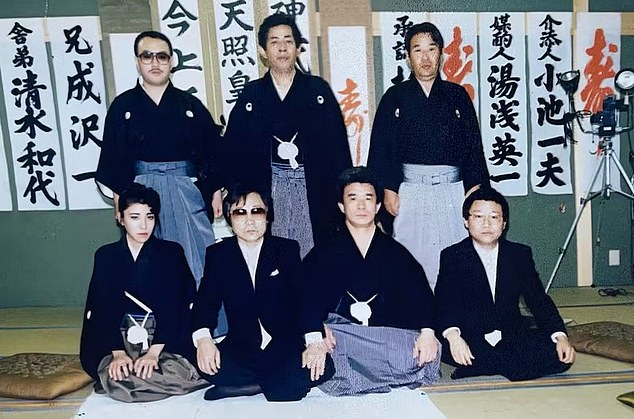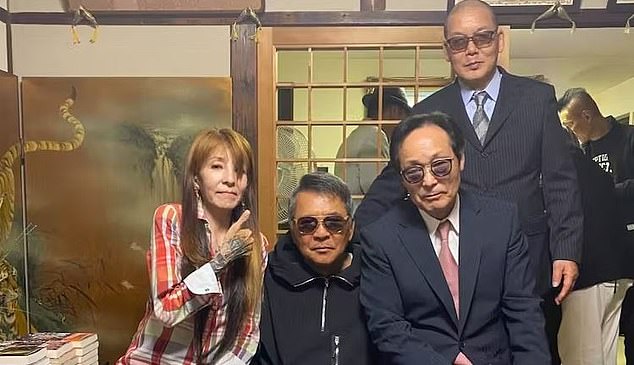The only woman to join Japan’s notorious yakuza: How a woman who ‘never lost a fight to a man’ caught the eye of gang boss in ‘bloodbath’ brawl and began life of crime that saw her slice off crooks’ fingers
Nishimura Mako is a petite woman in her late fifties, with wavy hair and a delicate face.
But you soon notice that she is not a traditional Japanese lady; she is tattooed up to her neck and hands and her little finger is missing.
These are signs of ties to the yakuza, Japan’s infamous criminal syndicates.
The yakuza is male-dominated and leaves only informal roles to women. A woman involved in the yakuza may typically be an anesan, the wife of a boss who cares for young relatives and mediates between them and her husband.
Women and partners of the members support the group in a peripheral way. Some become involved to the extent of managing yakuza clubs or dealing drugs.
When I interviewed Nishimura Recently, as part of my research, she told me that when she became involved in the yakuza at age 20, she took on both roles.
In the photo: Nishimura Mako during her internship. She is tattooed up to her neck and hands and her little finger is missing. These are signs of connection with the yakuza
But she went one step further: Nishimura is the only woman to ever participate in the sakazuki sake cup-exchanging ceremony. This is the ritual that confirms the formal bond with a yakuza group.
Nishimura was born into a strict family of government officials and had a strict childhood. Her memories revolve around her authoritarian father and the bamboo stick he used to discipline her.
During high school, she felt the urge to escape her family’s yoke, so she befriended unruly peers—and eventually motorcycle gangs (bōsozoku) who taught her how to fight.
This rebellious streak led her to a young yakuza member, who took her under his wing and showed her how to collect protection money, resolve disputes, commit blackmail, and scout girls for prostitution.
Her life took a turn when she got a call one evening: her friend was in a fight and needed help. She ran to help and used a bat to turn the scene into a massacre.
This caught the attention of the boss of the local yakuza group, who called her into his office. She told me that she remembers his words to this day: “Even if you are a woman, you have to become a yakuza.”
By then, she had been in juvenile detention several times and her family had abandoned their attempts to save her.
She accepted the boss’s invitation and began living the rigorous life of a yakuza trainee.
She joined a cohort of male recruits, performing daily tasks and eventually participating in the group’s criminal activities.
She eventually underwent the sakazuki ceremony, wearing a male kimono, and vowed her life to the path of the yakuza.

Nichimura Mako, bottom left, is the only woman to ever formally join a yakuza gang as a full member
As an affiliate, she ran prostitution and drug businesses, collected debts and mediated disputes between rival groups.
When she cut off her own little finger to apologize for a collective mistake in a ritual known as yubitsume, she realized she had a talent for it.
Members who could not perform the amputation themselves asked Nishimura to do it for them, earning her the nickname “master of finger snapping.”
But disillusionment set in as Nishimura reached her 30s, when meth became her group’s main trade and her own addiction began to take a heavy toll.
She ran away and ironically continued to run her meth business independently. She was kicked out of the group for this.
At this point she began a relationship with a member of a rival group, and a pregnancy led her to cut ties with the yakuza world in exchange for a quiet life raising her child.
But despite her efforts, her yakuza past – marked by her tattoos – kept her from getting a regular job. She married the father of her child, now a yakuza boss, and returned to prostitution businesses and drug trafficking.
After a second pregnancy, fights with her husband became increasingly violent, to the point that the police were called as soon as one broke out. They eventually divorced and he took custody of the two sons.
She rejoined her old group, but meth had changed hands which she loved, and within two years she left for good.
Nishimura lived as a male yakuza and retired as one. She found a job in the demolition industry and a modest home where she now lives alone.
She lives a quiet life, trying to be accepted by the community and help others. With the help of Mr. Fujimoto, a former yakuza himself, she also runs a chapter of Gojinkai, a charity dedicated to providing housing and assistance to former yakuza members, ex-convicts and addicts.

Respectable retirement: Nishimura with former yakuza colleagues working for Gojinkai, a charity dedicated to providing housing and assistance to former yakuza members, ex-prisoners and addicts
She says, ‘My day is not complete if I don’t come here in the evening.’ They gather around a table to talk about the past and present difficulties and to check in on each other. She is still the only woman at the table.
She emphasizes that what earned her respect in an all-male world is her capacity for violence: “I was good at fighting, I never lost to a man.”
But Nishimura doesn’t want to be a feminist icon: she didn’t set out to break gender stereotypes or announce herself as the only female yakuza.
There have been other women – such as Taoka Fumiko, widow of a yakuza boss – who, although not formally associated, have had a significant impact in the history of the yakuza.
But no one took such an extra step as Nishimura and became a completely loyal member with the cut off little finger.
Her story redefines the boundaries of gender roles and loyalty in the ruthless world of Japanese organized crime – a unique journey of identity and belonging.
